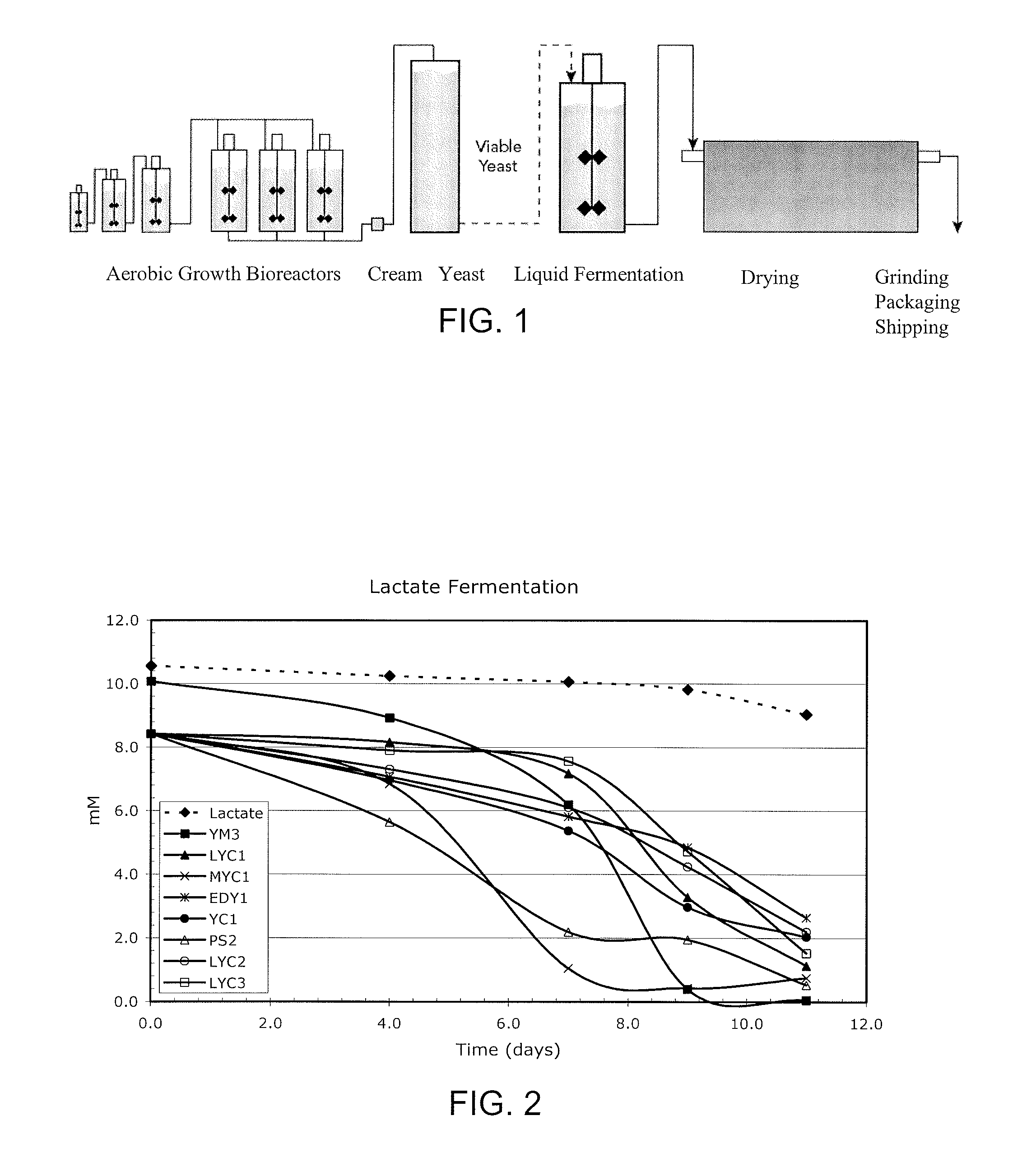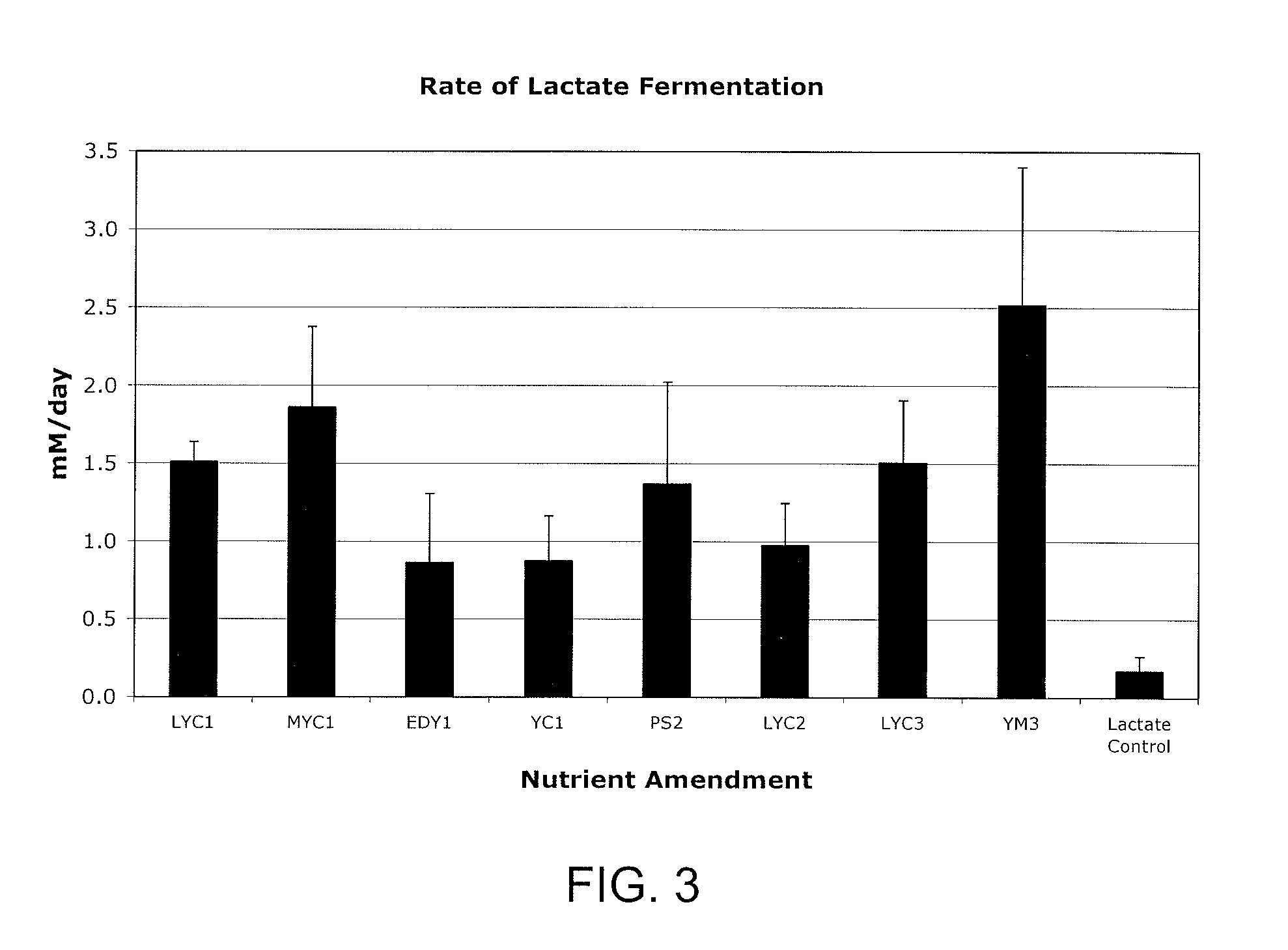New Bioremediation Enhancing Agents And Methods Of Use
a bioremediation and enhancing agent technology, applied in biochemistry apparatus and processes, biological water/sewage treatment, microorganisms, etc., can solve the problems of poor utilization rate of electron donors, poor efficiency, poor kinetics of lower cost electron donors, etc., to improve the microbial treatment of contaminated materials, improve the efficiency of electron donor utilization, and improve the effect of bioremediation kinetics
- Summary
- Abstract
- Description
- Claims
- Application Information
AI Technical Summary
Benefits of technology
Problems solved by technology
Method used
Image
Examples
example 1
VFA Screening Test
[0085]Volatile Fatty Acid (VFA) generation microcosm tests were used to characterize the rate of propionate generation, the absolute level of propionate generation and the molar ratio of propionate to acetate, a proxy for electron donor efficiency. The triplicate bottles were sampled five times over the first 11 days of the test.
[0086]The screening test evaluated the fermentation of sodium lactate amended with various yeast products and polysaccharides (bioremediation nutrients) in the presence of PCE. The nutrient amended lactate may be prepared by adding 3.9 g of bioremediation nutrient to 250 ml of sodium lactate 60% solution. The following bioremediation nutrients were evaluated in the screening tests:[0087]Live Yeast Cultures: LYC1, LYC2 and LYC3[0088]Yeast Culture: YC1[0089]Mixed Yeast Culture: MYC1[0090]Yeast Metabolites: YM3[0091]Enzyme Digested Yeast: EDY1[0092]Polysaccharide: PS2
[0093]The following components were used in the system for the VFA Screening ...
example 2
Set A: Ladder of YM
[0107]The following components were used in the system for bioremediating contaminated ground water microcosms in Examples 2-8:[0108]160 milliliter (ml) stoppered serum bottles[0109]100 ml of anaerobic culture medium, groundwater containing an excess of bioavailable phosphorus and nitrogen at 0.5 mM Phosphate and 1 mM ammonium degassed with a nitrogen sparge[0110]Nominally 1 gram of limestone[0111]19.54 micromoles (μmoles) Perchloroethene (PCE)[0112]An excess of various electron donors were utilized[0113]3 ml of inoculum containing dechlorinating bacteria known to convert PCE to ethene.
[0114]The first set of microcosms used sodium lactate as the electron donor at 7 mM in all the bottles. The four replicates were as follows:[0115]1% YM2[0116]10% YM2[0117]Lactate control—No YM[0118]No Lactate and 100 mg of YM2
[0119]The objective of this set was to characterize the improvement in kinetics from adding different levels of the YM2. The No Lactate bottles were used to de...
example 3
Set B: Erythorbate ML with and without YM2
[0123]The second set of microcosms used Erythorbate ML as the electron donor at 1020 mg / L initial concentration. The Erythorbate ML is the supernatant that remains after the recrystalization of Erythorbate from the mother liquor. The Erythorbate ML contains a mixture of 2 Keto-Gluconic Acid, Sodium Erythorbate and residual sugars like xylose, arabinose and succinate.
[0124]The objective of this set was to demonstrate that the YM2 would increase the microbial metabolic kinetics irrespective of which electron donor was used. In addition, this set was used to characterize if and to what extent Erythorbate ML was an efficacious electron donor for anaerobic bioremediation of contaminants in water. FIG. 8 shows that Erythorbate ML is capable of degrading PCE to ethene.
[0125]Tables 6-8 show the kinetic results, and include concentrations of PCE and its daughter products, Chloride generation and Chloride Rate and the associated standard deviation of ...
PUM
| Property | Measurement | Unit |
|---|---|---|
| concentration | aaaaa | aaaaa |
| volatile | aaaaa | aaaaa |
| molecular weight distributions | aaaaa | aaaaa |
Abstract
Description
Claims
Application Information
 Login to View More
Login to View More - R&D
- Intellectual Property
- Life Sciences
- Materials
- Tech Scout
- Unparalleled Data Quality
- Higher Quality Content
- 60% Fewer Hallucinations
Browse by: Latest US Patents, China's latest patents, Technical Efficacy Thesaurus, Application Domain, Technology Topic, Popular Technical Reports.
© 2025 PatSnap. All rights reserved.Legal|Privacy policy|Modern Slavery Act Transparency Statement|Sitemap|About US| Contact US: help@patsnap.com



